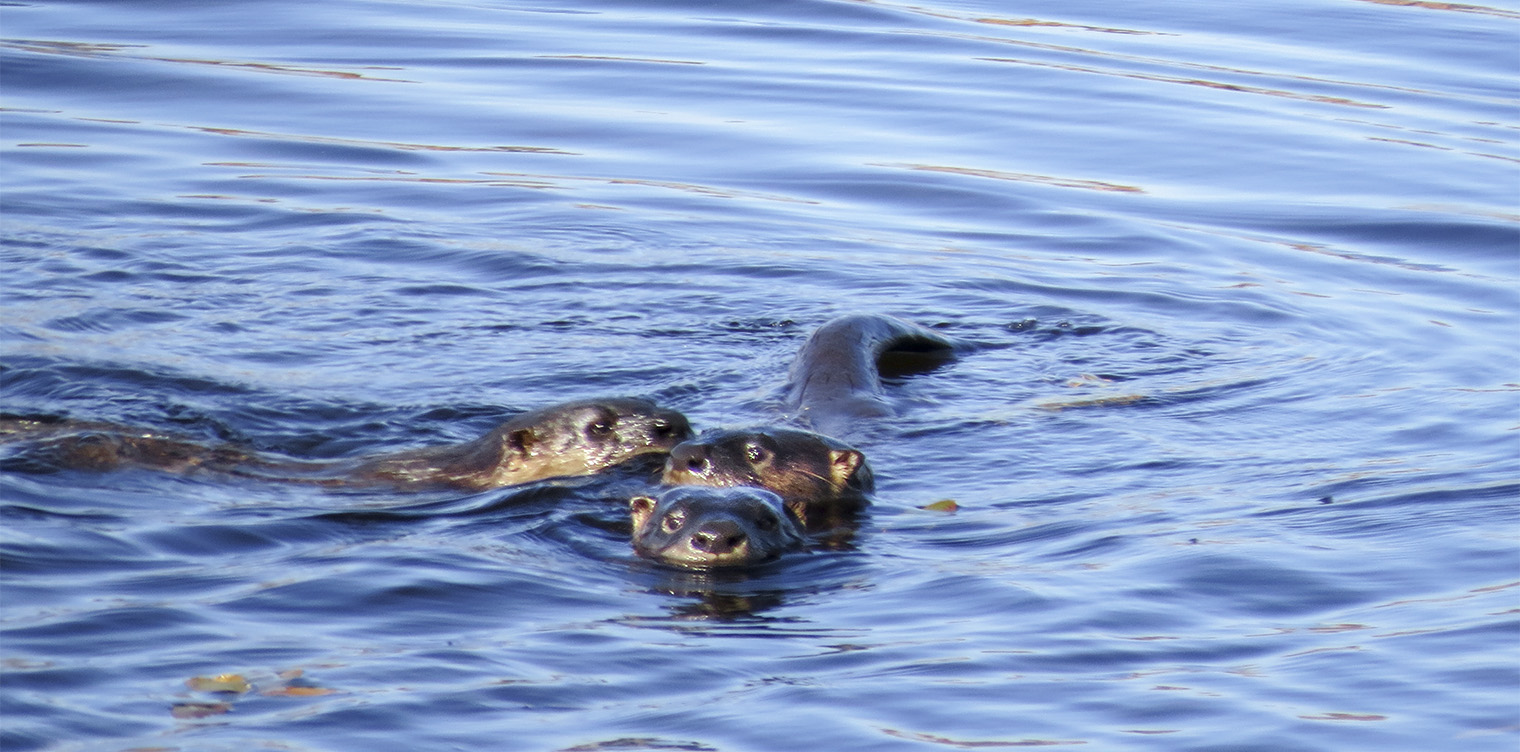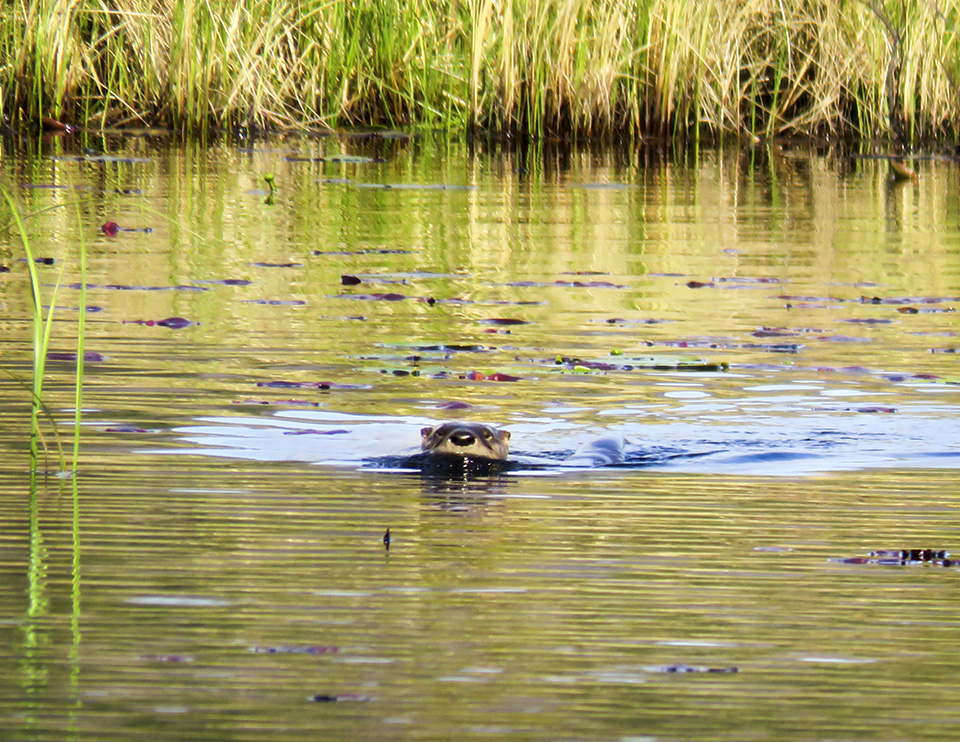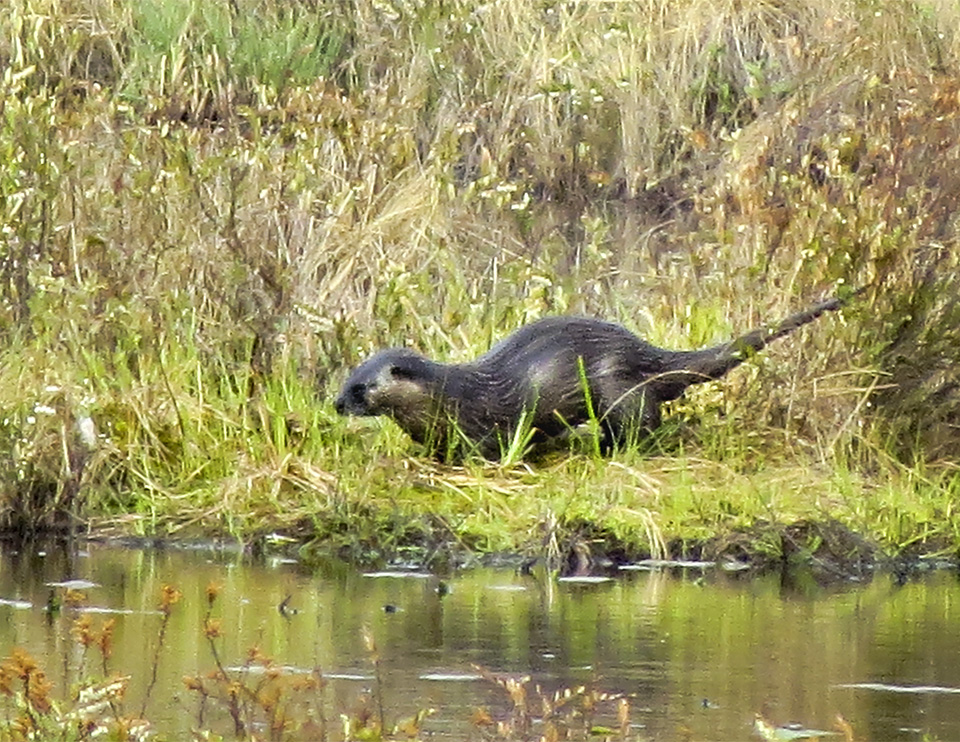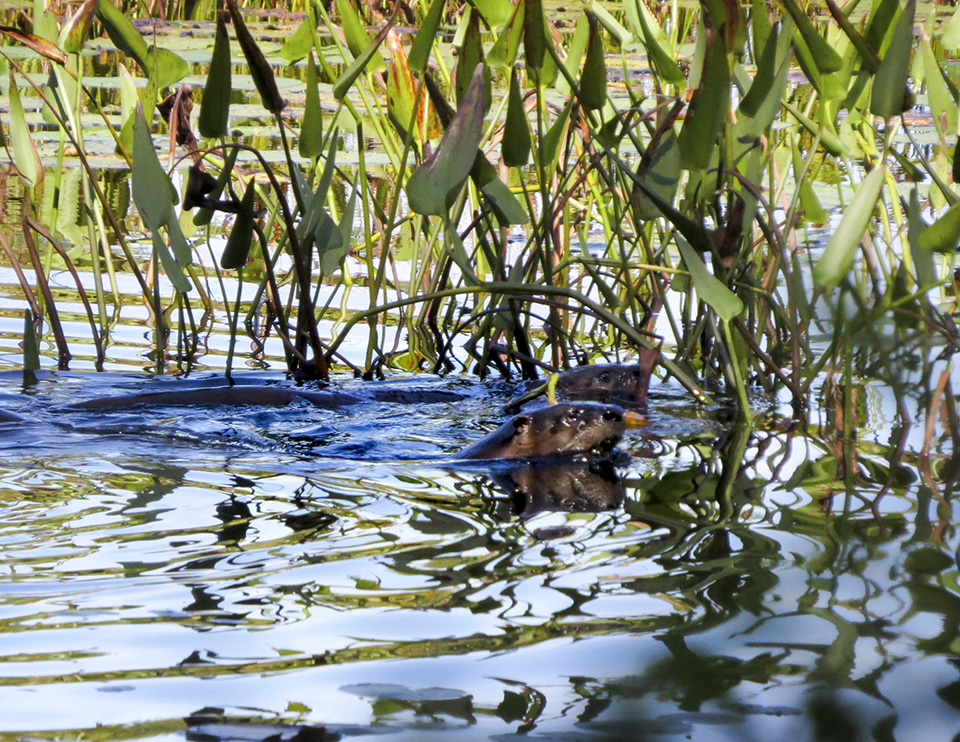Mammals of the Adirondacks:
North American River Otter (Lontra canadensis)

North American River Otters (Lontra canadensis) are members of the weasel family. They are a semi-aquatic mammal. This species reportedly has 28 common names in North America. Other nonscientific names include Nearctic River Otter, Northern River Otter, Canadian Otter, Land Otter, and Fish Otter.
There are seven subspecies. Our subspecies is Lontra canadensis canadensis, which is found in Eastern Canada, the Great Lakes, and the New England region.
History of the North American River Otter
When Europeans settled North America, the North American River Otter inhabited much of the continent. Otters were present in all major waterways in the US and Canada until at least the 19th century. Otter numbers dropped drastically in subsequent decades, due to human settlement and overharvest. Another key factor was habitat destruction, as millions of acres of wetlands were drained for agriculture and development. Otter numbers stabilized in the last few decades of the 20th century, due in part to reintroduction efforts.
The history of North American River Otters in New York State reflects these general trends. At one time, these mammals could be found in all watersheds in the state, but unregulated trapping, habitat destruction, and water pollution reduced their numbers. River otter populations began declining in parts of the state during the 19th century, becoming extirpated in many areas. Legal protection for otters was first established in 1936, leading to a resurgence in otter numbers. Until the early 1990s, however, few river otters could be found in the western half of the state. In response, the New York River Otter Project was established in the late 1990s; it involved trapping river otters in eastern New York and releasing them in the central and western part of the state.
North American River Otter: Description

North American River Otters have a long cylindrical body, with a broad, flat head and a bulbous nose. They have short, rounded ears set well back. The small eyes are set high on the head, closer to the nose than the ears. These animals have a thick, cylindrical neck and short, stocky legs.
North American River Otters can grow three to 4½ feet long; the tail constitutes 35-40% of the animal's total length. Otters in the wild weigh 7½ to 34 pounds. The largest subspecies is the Prince of Wales Island otter in Alaska; our subspecies is the smallest form. Females are 3% to 21% smaller than their male counterparts.
River otters have glossy, brown guard hairs over a short, oily underfur. The fur of northern and eastern forms is said to be darker, longer, and denser than that of the western and southern forms. Molts reportedly occur every year, beginning in late winter or early spring.
Otters are adapted for a semi-aquatic lifestyle. They are equipped with a long, muscular tail and webbed feet, which makes them swift and agile swimmers. They can remain submerged for several minutes at a time. They also have sensitive vibrissae – long, stiff hairs growing around the mouth which are used as organs of touch. These provide a means to detect prey moving in turbid water.
Otters do not have acute eyesight and are said to be nearsighted. However, they can detect movement at long distances. In addition, they have well-developed intraocular muscles, which give them better underwater vision. Their hearing is well-developed, as is their sense of smell.
North American River Otter: Diet
North American River Otters are carnivores and will consume almost anything they can catch. They are primarily visual predators. However, they also have motion-sensitive whiskers which enable them to forage in murky waters and find their prey by sensing vibrations with their whiskers.
Fish comprise the majority of their diet. Otters prey on a wide variety of fish species, depending on the availability of individual fish species and their swimming ability. Slow-moving fish species are more vulnerable to otter predation than fast-moving species, as are injured or weakened fish.
North American River otters will also eat crustaceans and other aquatic invertebrates, as well as various aquatic insects. Amphibians, particularly frogs, are occasionally taken, as well as turtles, including Painted Turtles. Birds, especially crippled or nesting birds, are also preyed upon, but are a relatively unimportant food item. Otters also occasionally prey on other mammals, particularly muskrats and young beavers, although these species are not a major item on the otter's menu.
North American River Otters capture their underwater prey with a quick lunge. Otters are fast swimmers, with a top swim speed of 10-12 kilometers per hour. They can remain underwater for several minutes, searching for prey by pushing rocks aside or chasing their prey underwater.
North American River Otter: Reproduction and Family Life
North American River Otters mate in late winter or early spring. The gestation period is 9½ to 12½ months. The young are born in April or May. Litter size varies from one to six pups. Newborn otters are relatively helpless; they are born blind, furred, and toothless. They open their eyes by 35 days and begin to venture outside the den at about 45 days, at which time the mother begins to teach them to swim and hunt. Weaning is completed by three to four months.
Adults provide the young food for up to 10 months. Males or a non-breeding female may remain with the family group temporarily. Juvenile otters usually remain with the female until she bears her next litter the following spring, dispersing when they are 12 to 13 months old. The main social unit is the family, generally one adult female and her young.
North American River Otter: Behavior

North American River Otters are usually nocturnal. Activity begins at dusk and continues through the night into midmorning. Peak activity is said to occur around midnight and just before dawn. There is no hibernation period. They are active year-round and may be more active during the winter, when they reportedly become more active during the daytime hours.
Otters move on land by walking, running, or bounding using alternate movements of the opposite forelimbs and hind limbs. Their most rapid form of movement on land is bounding, with the body arched and the tail held stiffly and used for balance.
In the water, the otter moves by thrusting with its hind limbs and propelling itself with the tail, which also serves as a rudder. North American River Otters reportedly swim at speeds up to 6 miles per hour. They can cover distances of up to 1,320 feet when submerged.
North American River Otters are social and playful animals, although their sociality is confined to family groups. The most typical family group consists of a reproductively active female and her young of the year.
- Otter Play Time: Highly energetic, river otters spend much of their time playing. They may be observed touching, shoving, tossing, and manipulating prey, stones or other objects, or tobogganing down mud or snow slides.
- Otter Vocalization: Otters are quite vocal, using chirping and humming sounds as contact calls. As you move through otter habitat, listen for the squeaks and chirps that otters use to keep in contact with each other.
North American River Otters also communicate by scent marking. They have anal scent glands and maintain scent posts throughout their range. These posts are thought to function primarily as a means of advertising the presence of individuals and groups, with the goal of minimizing contact with other groups of otters.
North American River Otter: Mortality and Predators
North American River Otters may live up to twenty years in captivity. However, they usually do not survive more than ten years in the wild. Although otters can suffer from a variety of viruses, bacteria, and diseases, as well as malnourishment, these are not thought to be major limiting factors on otter populations.
River otters have few nonhuman predators. Common Snapping Turtles, Eastern Coyotes, Bobcats, and foxes have been known to occasionally prey upon young otters. Otters are most vulnerable to attack by other mammals when traveling overland. However, none of these predators are thought to have a serious impact on otter population levels.
The North American River Otter's main predator is man. Otters have long been viewed as an economically important furbearer. In New York State, trapping of otters for their fur is legal in selected parts of the state. In the Adirondacks, the otter trapping season is from 1 November to 7 April. There is no bag limit.
North American River Otter: Distribution
North American River Otters occur in much of Canada and the United States, except for portions of the Southwest, and in Mexico in the Rio Grande and Colorado River delta areas. Otters are a common resident within the Blue Line in beaver ponds, streams, rivers, lakes, and marshes.
North American River Otter Habitat
North American River Otters can adapt to a wide variety of aquatic habitats. They are found living in rivers, lakes, ponds, small streams, marshes, and other inland wetlands. Their most favorable interior habitats are lowland marshes, swamps, and bogs connected by streams and lakes. Otters prefer water bodies with steep banks allowing access to both terrestrial and submerged habitat. Suitable habitat also has a high percentage of emergent vegetation.
River otters are often found in the same freshwater wetlands as beaver. Otter dens are usually found near water and often have underwater entrances. Otters generally do not excavate their own dwellings, but use the burrows of beaver or other mammals for their den sites. River otters usually use a variety of temporary dens, preferring sheltered sites such as rock cavities, logjams, and riparian vegetation. North American River Otters are usually not found in areas with polluted waters.
Where to See North American River Otters

The Tri-Lakes area offers two convenient places to see and learn about North American River Otters.
- To see North American River Otters in captivity, visit the Wild Center in Tupper Lake. The Wild Center currently has five otters – Louie, Scarlett, Squirt, Tawine, and Rohsnore – who were either rescued and saved by rehabilitators or born in captivity in other zoos. The Otter Falls exhibit area gives visitors close-up views of the otters swimming, eating and playing.
- Catching a glimpse of otters in the wild is a chancier venture. One likely place is Heron Marsh at the Paul Smith's College VIC, where otters are protected because hunting and trapping are not allowed. The best places for viewing these creatures are from the overlooks on the Heron Marsh Trail (particularly on the raised tower), on the floating bridge on the Woods and Waters Trail, and at Shingle Mill Falls on the Loggers Loop Trail. Otters have also been seen from the viewing platforms on the Barnum Brook Trail. Look for glimpses of their dark, shiny brown heads, moving quickly through the water on Heron Marsh. You might also spot an otter by looking for its wake in the water. At the VIC, young otters may be seen playing on Heron Marsh, especially during the fall. The best time to catch sight of an otter at the VIC is early morning or late afternoon.
You can also watch for signs of otter activity when the animals themselves are not visible. During winter walks, look for evidence of otter play in the form of slide marks in the snow. At the VIC, a good place to be on the look-out for such marks is at the marsh outlet at Shingle Mill Falls, where otters have tobogganed over the falls.
Adirondack Mammal List
References
New York State Department of Environmental Conservation. River Otter. Retrieved 28 March 2017.
New York State Department of Environmental Conservation. Watchable Wildlife: River Otter. Retrieved 6 October 2014.
New York State Department of Environmental Conservation. River Otters (video). Retrieved 14 January 2019.
New York State Department of Environmental Conservation. Otter Trapping Seasons. Retried 24 September 2019.
State University of New York. College of Environmental Science and Forestry. River Otter. Retrieved 28 March 2017.
United State Environmental Protection Agency. Wildlife Exposure Factors Handbook. pp. 261-273.Retrieved 28 March 2017.
Wayne E. Milquist, Paul J. Polechla, Jr., and Dale Toweill, "River Otter," in George A. Feldhamer, Bruce C. Thompson, and Joseph A. Chapman (Eds). Wild Mammals of North America: Biology, Management, and Conservation. Second Edition (The Johns Hopkins University Press, 2003) pp. 708-734.
Steve Boyle. North American River otter (Lontra canadensis): A Technical Conservation Assessment (USDA Forest Service, 2 September 2006).
United States Department of Agriculture. Fire Effects Information System (FEIS). Species Reviews. Lontra canadensis. Retrieved 28 March 2017.
iNaturalist. North American River Otter. Lontra canadensis. Retrieved 27 October 2021.
iNaturalist. Adirondack Park Observations. North American River Otter. Lontra canadensis. Retrieved 27 October 2021.
Smithsonian National Museum of Natural History. North American Mammals. Lontra canadensis. Retrieved 14 January 2019.
Serge Lariviere and Lyle R. Walton, "Lontra canadensis," Mammalian Species, No. 587, 1 June 1998, pp.1-8. Retrieved 14 January 2019.
National Wildlife Federation. Wildlife Library. North American River Otter. Retrieved 14 January 2019.
IUCN Red List of Threatened Species. Lontra canadensis. Retrieved 28 March 2017.
University of Michigan. Animal Diversity Web. Lontra canadensis. Retrieved 28 March 2017.
National Geographic. North American River Otter. Retrieved 28 March 2017.
William K. Chapman. Mammals of the Adirondacks. A Field Guide (North Country Books, 1991), pp. 13, 104, 106, 146, Plate 17.
James M. Ryan. Adirondack Wildlife. A Field Guide (University of New Hampshire Press, 2008), pp. 205-206.
Donald W. Stokes and Lillian Q. Stokes. A Guide to Animal Tracking and Behavior (Little, Brown and Company, 1986), pp. 354-363.
Curt Stager. Field Notes from the Northern Forest (Syracuse University Press, 1998), pp. 166-167.
John O. Whitaker, Jr. and William J. Hamilton, Jr. Mammals of the Eastern United States (Cornell University Press, 1998), pp. 465-469.
Romeo M. Spinola, Thomas L. Serfass, and Robert P. Brooks, “Survival and Post-Release Movements of River Otters Translocated to Western New York,” Northeastern Naturalist, Volume 15, Number 1 (2008), pp. 13-24. Retrieved 27 September 2019.
